Requiem shark facts for kids
Quick facts for kids Requiem sharks |
|
|---|---|
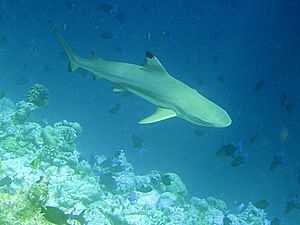 |
|
| Blacktip reef shark, Carcharhinus melanopterus | |
| Scientific classification |
|
| Kingdom: | Animalia |
| Phylum: | Chordata |
| Class: | Chondrichthyes |
| Order: | Carcharhiniformes |
| Family: | Carcharhinidae D. S. Jordan & Evermann, 1896 |
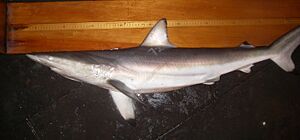
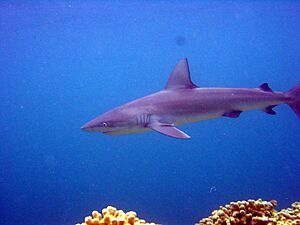
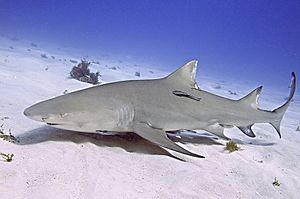
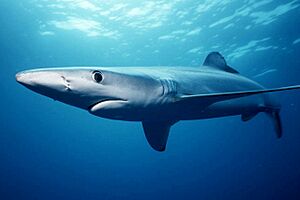
Requiem sharks are a group of sharks belonging to the family Carcharhinidae. They are part of the larger group called Carcharhiniformes. These sharks are known for traveling long distances and giving birth to live young. They mostly live in warm ocean waters, but some can be found in brackish (slightly salty) or even fresh water.
Some well-known requiem sharks include the bull shark, lemon shark, spinner shark, blacktip shark, grey reef shark, blue shark, and oceanic whitetip shark. These sharks have round eyes and one or two gill slits that are located near the base of their pectoral fins. Most species give birth to fully developed baby sharks. Requiem sharks vary a lot in size. The smallest, like the Australian sharpnose shark, can be about 69 cm (2.26 ft) long. The largest, such as the oceanic whitetip shark, can grow up to 4 m (13 ft) long. Scientists believe their pectoral fins are shaped to help them swim efficiently.
Requiem sharks usually live in tropical areas and often migrate. Female sharks release special chemicals into the ocean to let males know they are ready to mate. Mating typically happens from spring to autumn. While requiem sharks are sometimes involved in shark attacks on humans, it can be hard to tell exactly which species was involved. This makes attack records a bit unclear.
Contents
What's in a Name?
The common name requiem shark might come from the French word for shark, requin. The origin of requin is debated. Some think it comes from the Latin word requiem, meaning "rest." Others believe it comes from an Old French word, reschignier, which means "to grimace while showing teeth."
The scientific name Carcharhinidae was first used in 1896. It was proposed by scientists D.S. Jordan and B.W. Evermann. This name comes from two Greek words: karcharos (meaning sharp or jagged) and rhinē (meaning rasp). Both words describe the rough, rasp-like skin that sharks have.
Shark History
The oldest known requiem shark is called Archaeogaleus lengadocensis. It lived a very long time ago, during the Early Cretaceous period in France. Not many records of this group exist from before the Cenozoic Era. Modern requiem sharks have become very diverse, especially in coral reef habitats.
How Requiem Sharks Hunt
Requiem sharks are incredibly fast and skilled hunters. Their bodies are long and shaped like a torpedo, which helps them swim quickly and move easily. This allows them to attack their prey with speed and agility. They eat a variety of foods depending on where they live and what species they are.
Their diet can include bony fish, squids, octopuses, lobsters, turtles, marine mammals, seabirds, and even other sharks and rays. They are sometimes called the "garbage cans" of the sea because they will eat almost anything, even things that aren't food, like trash. These sharks are migratory hunters, meaning they follow their food sources across entire oceans. They are often most active at night, using their excellent eyesight to sneak up on prey. Most requiem sharks hunt alone. However, some species, like whitetip reef sharks and lemon sharks, work together. They hunt in groups, using coordinated attacks to catch their prey.
Types of Requiem Sharks
There are 59 known species of requiem sharks, which are grouped into 11 main categories called genera. Here are some of them:
- Genus Scoliodon
- Scoliodon laticaudus (spadenose shark)
- Scoliodon macrorhynchos (Pacific spadenose shark)
- Genus Carcharhinus
- Carcharhinus acronotus (blacknose shark)
- Carcharhinus albimarginatus (silvertip shark)
- Carcharhinus altimus (bignose shark)
- Carcharhinus amblyrhynchos (grey reef shark)
- Carcharhinus brachyurus (copper shark)
- Carcharhinus brevipinna (spinner shark)
- Carcharhinus falciformis (silky shark)
- Carcharhinus galapagensis (Galapagos shark)
- Carcharhinus leucas (bull shark)
- Carcharhinus limbatus (blacktip shark)
- Carcharhinus longimanus (oceanic whitetip shark)
- Carcharhinus melanopterus (blacktip reef shark)
- Carcharhinus obscurus (dusky shark)
- Carcharhinus plumbeus (sandbar shark)
- Carcharhinus signatus (night shark)
- Genus Glyphis
- Glyphis gangeticus (Ganges shark)
- Glyphis glyphis (speartooth shark)
- Genus Lamiopsis
- Lamiopsis temminckii (broadfin shark)
- Genus Nasolamia
- Nasolamia velox (whitenose shark)
- Genus Negaprion
- Negaprion brevirostris (lemon shark)
- Genus Prionace
- Prionace glauca (blue shark)
- Genus Rhizoprionodon
- Rhizoprionodon acutus (milk shark)
- Rhizoprionodon terraenovae (Atlantic sharpnose shark)
- Genus Loxodon
- Loxodon macrorhinus (sliteye shark)
- Genus Isogomphodon
- Isogomphodon oxyrhynchus (daggernose shark)
- Genus Triaenodon
- Triaenodon obesus (whitetip reef shark)
Images for kids
See also
 In Spanish: Carcarrínidos para niños
In Spanish: Carcarrínidos para niños





